One day, on a wet, swampy piece of land near present-day Glasgow, Montana, an egg hatched and a Tyrannosaurus Rex climbed from the shell taking her first steps. It was the beginning of a story that continues today, all throughout eastern Montana.
Today, the egg is long gone. When that dinosaur lay to rest on the banks of the Missouri River it settled into place, slowly being covered by sediment, and remained unseen for 66 million years.
Until one Saturday morning in 1988, rock-hounder Kathy Wankel was walking the banks of a small island in the Fort Peck Reservoir and a shoulder-blade-shaped object protruding from the mud stopped her in her tracks.
Skip to:
- What did Montana look like during the dinosaurs? (a brief summary of each period)
- Triassic period
- Jurassic period
- Mid-Cretaceous
- Late-Cretaceous
- Cenozoic (after the extinction)
- What kind of dinosaur fossils have been found in Montana?
- Why did Montana have so many dinosaurs?
- What did Montana look like after the dinosaur extinction?
- Brief, simple, easily-digestible summary of Earth’s entire history (For context)
What did Montana look like during the dinosaurs?
Non-avian (non-bird) dinosaurs ruled the area of present-day Montana for 165 million years during the Mesozoic era. Throughout the Mesozoic Era, Montana had a variety of different climates and landscapes, including hot, swampy, lowlands, and dry, arid desert. The state was even covered by seawater several times during this period.
Overall, the climate and geography during the time of dinosaurs in Montana were very different from today.
Here’s what Montana looked like during the dinosaur era:
Triassic period – 252 to 201 million years ago (Mya)
Pangea had yet to split into the seven continents and Montana was twice covered by a sea³ that stretched along the entire western coast of North America.
Land regions in south-central Montana were hot, dry, and deserty, divided by several streams³.
Jurassic period – 201 to 145 Mya
An inland sea reached Montana during this time, called the Western Interior Seaway, which split North America in half and covered much of Montana³.
Much of Montana was warm and tropical during this period².
Cretaceous period – 145 to 66 Mya
Western Montana was covered in swampy, green, flourishing lowlands, covered in flowers, undergrowth, trees, and canopy⁴.
Eastern Montana lay mostly submerged under the interior seaway. This was a period of mountain building and violent volcanic eruptions³.
Cenozoid era – 66 Mya to today (post-dinosaur)
The climate alternated between dry and arid to wet and tropical². Montana later decended into multiple Ice Ages with much of the state covered by glaciers – home to mammoths, dire wolves, and musk oxe².
Let’s discuss what Montana looked like during dinosaurs in more detail.
Triassic (252 – 201 Mya) – Montana is a hot, dry, desert divided by streams
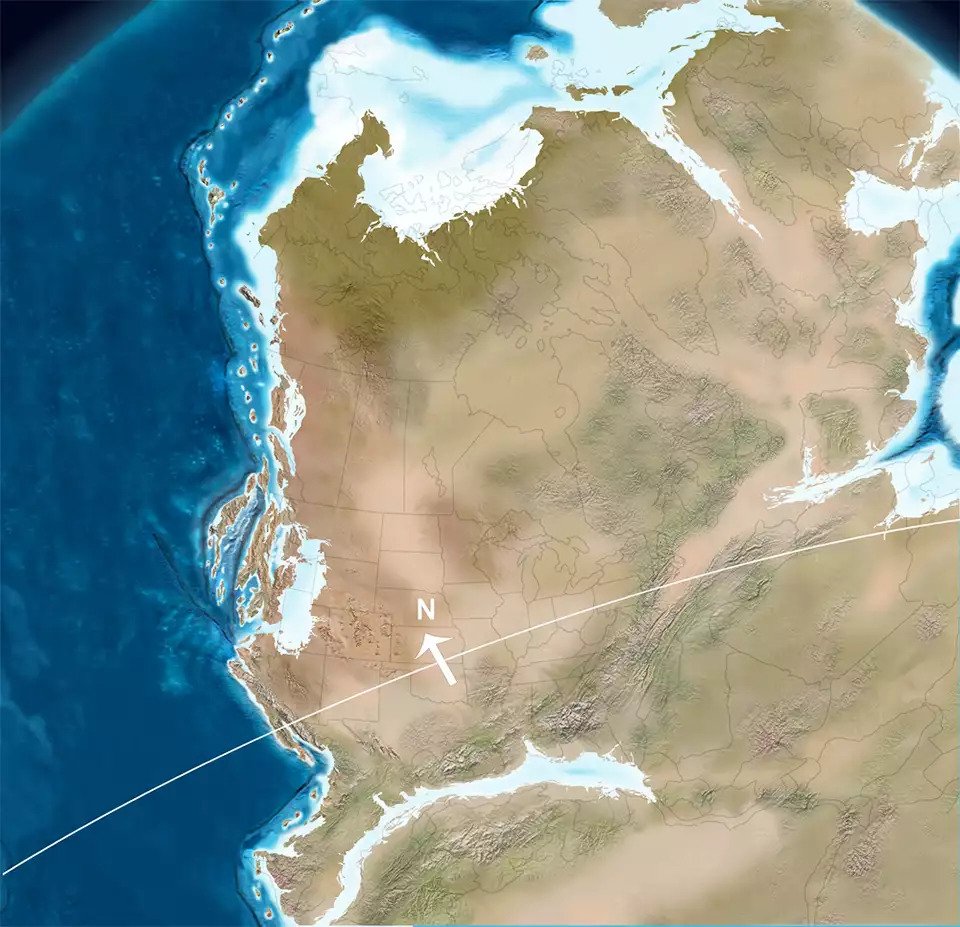
© Dr. Ron Blakely, NAU Geology, Colorado Plateau Geosystems, via thearmchairexplorer.com
Landscape
Throughout the Triassic period, Pangea had yet to split into the seven continents.
Montana was covered by seawater twice³. A shallow sea stretched down the western shores of North America, from present-day California, up to northern Canada, reaching inland to Montana³.
At one point, this sea covered a region of southwestern Montana³.
Climate and geography
Land in south-central Montana during this time was a hot, dry, desert, cut by various streams³.
Dinosaurs of the time
Chindesaurus and Coelophysis were two of the dinosaurs roaming North America during the Triassic1, though we couldn’t confirm which ones called Montana home.
Jurassic (201 – 145 Mya) – Montana is mostly under seawater, but its dry land is warm and tropical
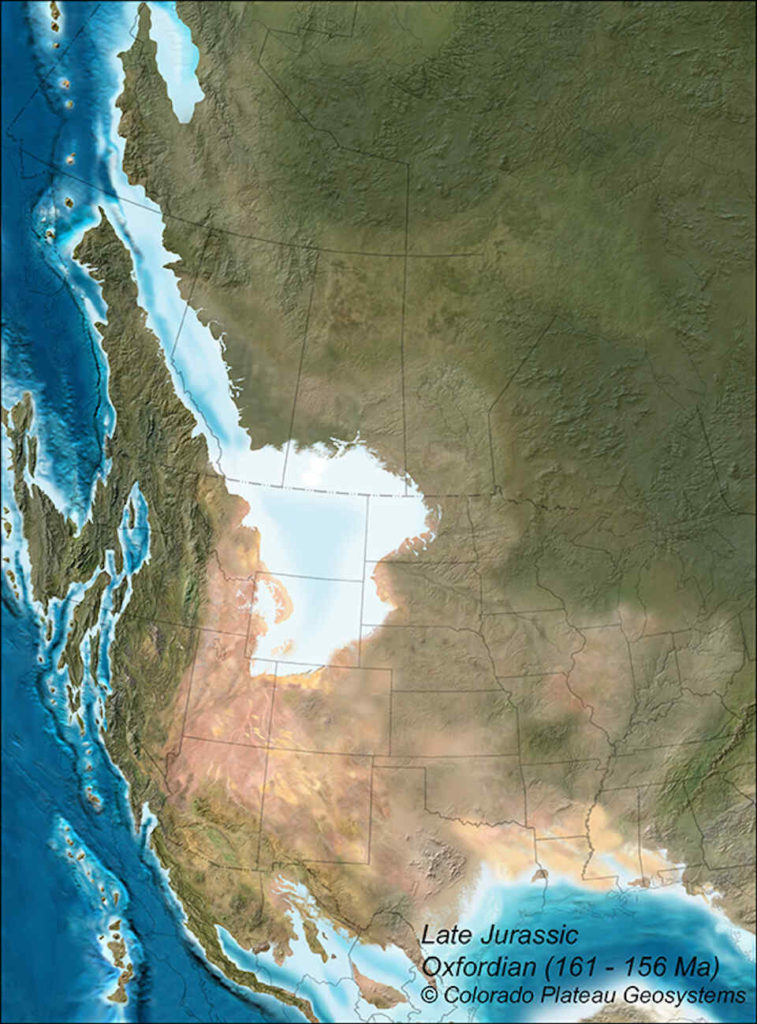
© Dr. Ron Blakely, Colorado Plateau Geosystems
Landscape
Throughout the Jurassic period, warm seas slowly returned to Montana³, covering much of the state at one point.
A sliver of water stretched from the Arctic Ocean across Canada to northern Montana and western North Dakota. Most of the state was under seawater. There was even an island in southwestern Montana at one point³.
Climate and geography
The interior seaway brought with it a warm and tropical climate². Montana’s flora included ferns, ginkgoes, cycads, and conifers³.
Dinosaurs of the time
The coastal plains around the state were home to Camptosaurus, Allosaurus, and Apatosaurus³.
Mid Cretaceous (145 – 100 Mya) – Montana is a volcanic, moist, swampland, mostly covered by sea
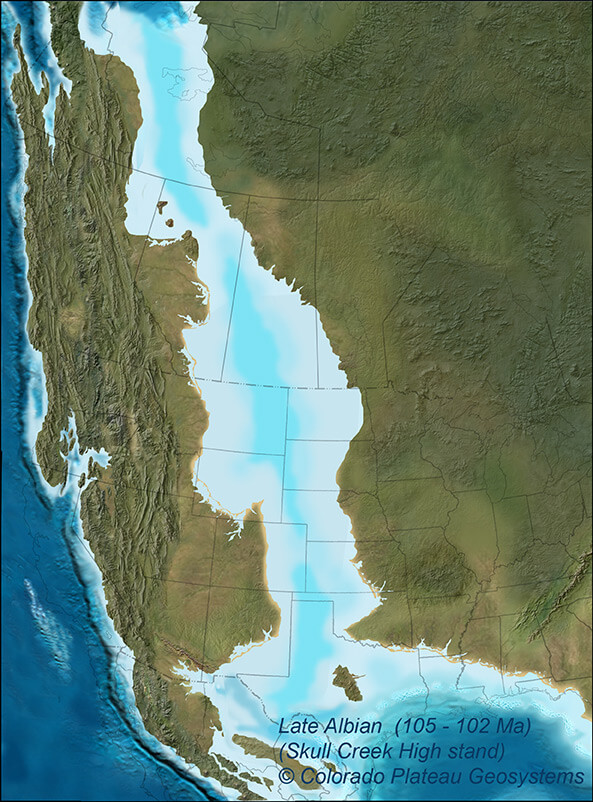
© Dr. Ron Blakely, Colorado Plateau Geosystems
Landscape
Throughout the Cretaceous period, Montana was mostly covered by seawater³ (Western Interior Seaway), with the western edge of the state a shoreline, and southwest Montana a dry land.
This sea stretched from the Arctic Ocean to the Gulf of Mexico, splitting North America into two landmasses, with Montana on its western shore and Minnesota on its eastern shore. States in between, such as Wyoming and Nebraska, were fully submerged.
West of Montana, a vast plain extended to the recently formed Rocky Mountains, which was composed of sandstone and mudstone, common formations of this type of coastal region⁴.
Climate and geography
While most of Montana was covered in sea, small regions, such as in the southwestern part of the state were dry³. Flowering plants first appeared in Montana during this time³.
Dinosaurs of the time
Acrocanthosaurus, Deinonychus, Gastonia, Supersaurus, Silvisaurus, were some of the dinosaurs of North America in the Cretaceous⁷, though we couldn’t confirm which ones called Montana home.
Late Cretaceous (100 – 66 Mya) – Montana is a volcanic, desert in the west, but hot and humid in the east
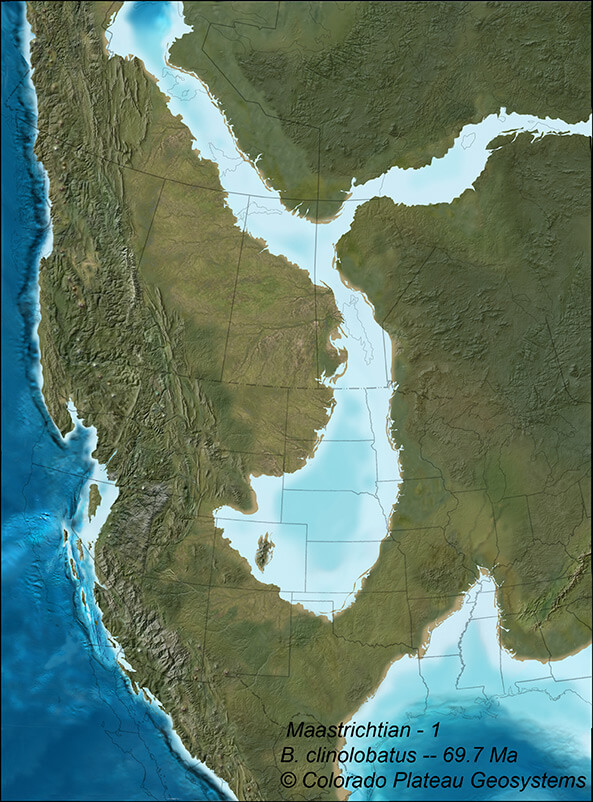
© Dr. Ron Blakely, Colorado Plateau Geosystems
Landscape
The Western Interior Seaway began receding, reuniting the two halves of North America³.
Climate and geography
As the water receded, the Rocky Mountain region became a desert³. By contrast, eastern Montana became hot and humid, with a warm, moist, subtropical climate⁴.
Eastern Montana was humid with flowering plants, swamp ferns, conifers, undergrowth plants, oak trees, and shrubs in forests with a canopy⁴.
During this time, there was no winter or cold season, and most likely Montana received a lot of precipitation⁴. Significant volcanic eruptions also occurred during this time³.
Large rivers flowed across eastern Montana depositing sediments that would form much of the Hell Creek formation³, a region covering part of eastern Montana where many dinosaur fossils have been discovered.
Dinosaurs of the time
During this time, Montana was home to some of the most well-known dinosaurs, including Triceratops, Tyrannosaurus, and Edmontosaurus, as well as Duckbilled hadrosaurs, such as Maiasaura³.
Cenozoic (66 Mya – Today) – Montana is a swamp, but soon the Ice Age hits
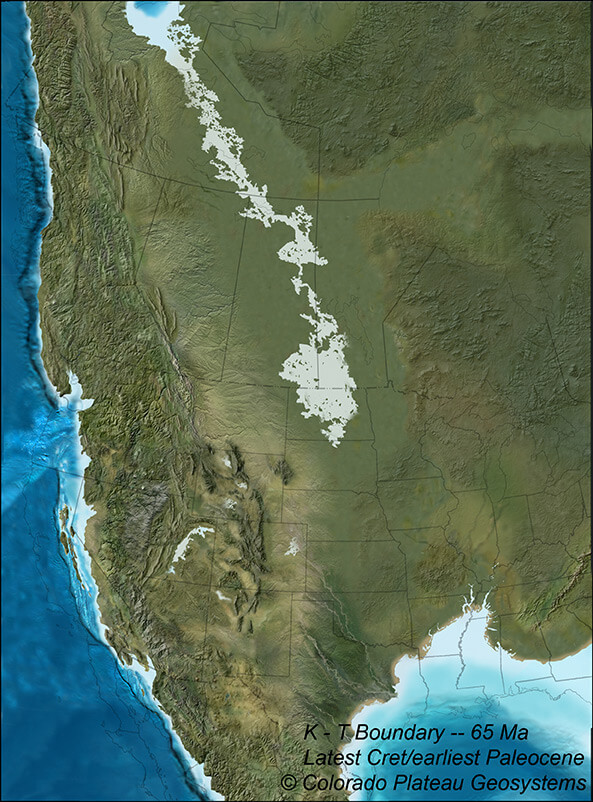
© Dr. Ron Blakely, Colorado Plateau Geosystems
Landscape
The start of the Cenozoic Era marks great extinction event and the end of dinosaurs on Earth. This Era consists of the last 66 million years of Earth’s history up to today.
During the beginning of the Cenozoic era, the Western Interior Seaway had mostly receded for the last time³, revealing eastern Montana and the other submerged states of the central United States.
Climate and geography
This was a period of extreme tectonic activity, which resulted in many local mountains and raised Montana’s elevation³.
At this time, Montana consisted of swamps, with water lily, lotus, ash, dogwood, elm, gooseberry, liverwort, false strawberry, and many other flora³.
Later in this period, closer to today, Montana became colder and wetter³. Two Ice Ages fell over Montana in the past 140,000 years, with glacial activity covering much of the state during each one⁸.
Animals of the time (after dinosaur extinction)
Invertebrate fauna in Montana during this time included beetles, lantern flies, grasshoppers, mosquitos, and wasps³. At one point, Montana was home to horses and camels³.
As Montana developed colder climates, regions of the state became home to mammoths, dire wolves, and musk oxe³.
What kind of dinosaur fossils have been found in Montana?
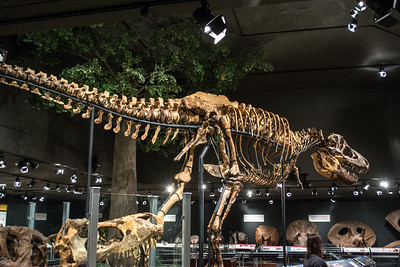
Within the last several decades, 75+ dinosaur fossils have been discovered in Montana, including Diplodocus, Stegosaurus, and the ferocious Allosaurus, a similar dinosaur to the T Rex.
Roughly 12 T Rex fossils have been found in Montana, some of which are some of the most complete fossils ever found in the United States.
A portion of eastern Montana lies over the Hell Creek Formation, an area formed during the Cretaceous where thousands of dinosaur fossils have been discovered since 1901.
In our article about the history of dinosaurs in Montana, you can find a large, noncomprehensive, list of the dinosaur fossils found in Montana and the species that lived in the state.
Why did Montana have so many dinosaurs?

Montana didn’t have an exceptionally large dinosaur population. However, an exceptionally large number of dinosaur fossils have been found in the state. In another article, we explain why so many dinosaur fossils ended up in Montana, as opposed to some other regions of North America.
Montana-born paleontologist Jack Horner discovered a nest of dinosaur eggs in Montana, which served as evidence that dinosaurs care for their offspring and nest in groups.
Discover Jack Horner’s amazing dinosaur discoveries in Montana and his incredible journey to becoming a paleontologist in our article, “Who is Jack Horner?“.
What did Montana look like after the dinosaur extinction?
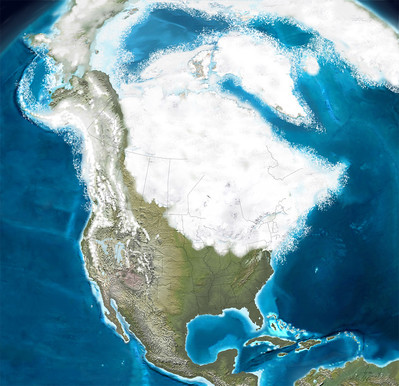
After living on present-day Montana for 165 million years, a mass extinction event at the end of the Cretaceous period ended dinosaur life on Earth.
About 62 million years after the dinosaur extinction, several Ice Ages wrapped the northwest United States in a blanket of ice. For 2.5 million years⁹, glaciers migrated and melted, slowly reshaping the land and rerouting rivers.
The Laurentide and Cordilleran ice sheets rerouted the Missouri, Yellowstone, and Musselshell Rivers of Montana to their present-day paths, all of which used to flow northward into a terminal lake (a body of water with no exit).
Glaciers pulled soil and water with them, burying physical objects and reshaping anything in their path.
That glistening object that Kathy Wenkel stumbled upon that Saturday in 1988 near Fort Peck Dam had been pushed around by glacial migrations until it finally rest on the shores of the Missouri River, wrapped in a deep geological embrace for millions of years.
It wasn’t until long after Europeans had colonized the Americas and settled the continental U.S. that many of them would reappear in eastern Montana and the surrounding states.
Discover Montana’s dinosaur history on the Montana Dinosaur Trail
Today, 14 different locations throughout Montana offer insight into Montana’s Dinosaur history. Together, they comprise the ‘Montana Dinosaur Trail’.
Find out what each site features in our article on the Montana Dinosaur Trail.
A brief, simple, easily-digestible summary of Earth’s entire history (For context)

© A. MacRae 1998 based on Harland, W.B. et. al., 1990, and Gradstein, F. and Ogg, J., 1996.
For those of you who are new to Earth’s entire history and want to understand exactly when dinosaurs roamed the Earth (and Montana), here’s a quick summary for context:
Geologists break Earth’s entire history into eons, eras, and then periods (above image).
The first eon (Precambrian) dates back 4,500 million years – there were some creatures, such as jellyfish in the oceans, but the land was bare.
The following eon (Phanerozoic), which spans from 541 Mya to today, is broken into three eras, one of which was the era of dinosaurs – The Mesozoic.
In the image above, I’ve pointed to the three time periods we covered in this article in which dinosaurs roamed across Montana.
Sources:
- Natural History Museum – Dinosaurs from the late Triassic
- The Paleontology Portal
- Paleontology in Montana
- Hell Creek Formation
- National Geographic
- Smithsonian Institution
- Natural History Museum – Dinosaurs in the late Cretaceous
- Montana Department of Transportation
- American Museum of Natural History

